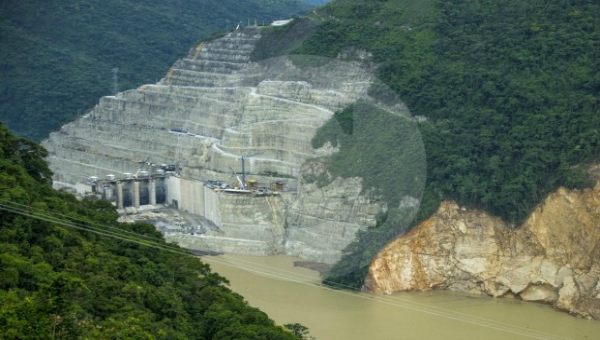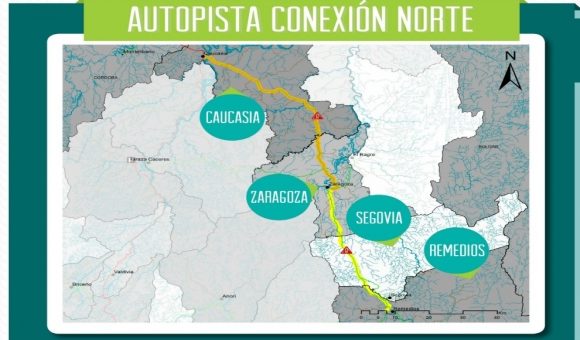Colombia’s National Engineering Society Sees Possible Solutions to Hidroituango Crisis

The Sociedad Colombiana de Ingenieros — (SCI, the Colombian national association of engineers) — on June 6 announced that several possible solutions are seen arising to overcome the current crisis affecting EPM’s under-construction, 2.4-gigawatt “Hidroituango” hydroelectric dam in Antioquia.
The US$5 billion “Hidroituango” project would supply 17% of Colombia’s entire national electricity demand once completed — although the current crisis has forced EPM to postpone the original, partial start-up of December 2018 to some as-yet-unknown, future date.
According to the SCI announcement (obtained by Medellin Herald), a special commission of SCI engineers met with EPM last week to review the various engineering challenges facing the project.
Below is the complete SCI statement, translated from Spanish to English by Medellin Herald:
“Last Friday, June 1, 2018, a special commission of the SCI, convened by its President [Argelino J. Duran Ariza] for the purpose, was received at the EPM facilities by EPM general manager Dr. Jorge Londoño, and the engineers Carlos Eduardo Isaza and Luis Fernando Restrepo, President and Infrastructure Manager of INTEGRAL SA, the firm that designed the project and advises [EPM] during the construction.
“The purpose of the meeting was to obtain first-hand information about the current status of each of the components of the project, the associated risk factors, and the measures being taken to reduce the threats that may affect the communities downstream of the project, and the project itself.
“The verbal information received at the meeting is consistent with the report of the commission of experts sent by the North American government, made known over the weekend, which indicates several threats that may affect the project, with potential effects on the communities downstream of it, including:
“1. Debris [landslides] from the slopes above the reservoir with the potential effect of generating a wave that could overtop the height of the dam, or plug the [water-capture-and-escape tunnel] in the machine house, and/or the [engineered] spillway.
“2. Unchecked loss of control of the right [water] deviation tunnel, which currently discharges 100 cubic meters per second.
“3. Undesirable infiltrations [of Cauca River water] through the dam at level 380 [meters above sea level], with the new design adopted for the so-called ‘priority landfill,’ which [potentially] could lead to its failure.
“As for possible damage suffered in the cavern of the machine house, the special commission of the SCI was informed that according to the monitoring carried out, the cavern has not suffered any appreciable damage. Neither has there been detected any possibility of failure of the rock mass of the right massif [the mountain above the dam and machine house] and that all the underground [diversion tunnel blockage] events to date have been related to the location of the geological fault called Los Mellizos.
“EPM informed us that in order to empty the reservoir [behind the dam], there is a possibility of constructing a discharge system with a vertical well to which three existing reservoir arms [the routine drainage systems used in all hydroelectric dams] would be connected. However, it is not clear how much time would be required to build this, although it would be a process of several months.
“EPM expects that the flows of the Cauca River will behave according to historical records and decrease ostensibly from the second week of June, so that the decline in the level of the reservoir begins. This descent would eventually reach level 385 [meters above sea level], which would allow closing the gates of water-capture tunnels 1 and 2 [connecting to] the machine house, the only ones where the water is [now] entering. If such a decision were made, then the only controllable evacuation of the reservoir water would be through the [engineered] spillway [near the top of the dam, at 401 meters above sea level].
“The commission of the SCI was informed of the different monitoring systems that EPM has implemented in the project, and the formation of the integrated information center, which will give continuous results to feed the decisions that the Unified Command Post must adopt, in order to activate the corresponding alerts for the protection of the lives of workers and communities in the basin.
“At the date of our meeting, [EPM] reported that they are formulating a risk-assessment model linked to the instrumentation, and to the evaluation of the necessary time between the issuance of the alert and the occurrence of an event, in order to determine the time required for the possible scenarios and perform evacuation processes.
“The members of the SCI commission suggested some additional actions for consideration by the technical teams of the project, which were well received by EPM and its advisors.
“As a result of the analysis of the information received, the SCI found:
“1. Since the beginning of the emergency, EPM has adopted measures and actions to protect the stability of the works, seeking to reduce the threats to protect the stability of the works and seeking to reduce the threats that materialize, given the circumstances. Said measures correspond to: accelerated enhancement [raising the height] of the dam, evacuation of water through the machine house, and completion of the spillway. For these tasks and to face the various technical challenges that arise, EPM has had experts from the national consulting firms INTEGRAL and INGETEC, and several international experts of global relevance.
“2. It is unquestionable that all identified threats, as well as some other events that may affect the behavior of the dam, will disappear when the reservoir can be emptied in a controlled manner.
“3. Up to now there is no modeling that allows determining the probability of the occurrence of events caused by the threats mentioned, or others not yet identified, so it is not possible to predict with certainty when one of them may occur.
“4. The SCI has not had access to the report presented by the North American commission of experts regarding [allegedly non-optimal material used for the emergency raising of the dam to 410 meters] standards, so we cannot endorse the [North American commission] recommendations not to plug the right diversion tunnel or not to close the water passage through the machine houses, which EPM should evaluate.
“5. The project is still in high-risk condition, which puts the populations below the dam in high-risk condition. It is expected that the monitoring systems allow to anticipate alerts and possible evacuation orders in a timely manner. Therefore, EPM urges the inhabitants to be in permanent attention to the issuance of warnings and evacuation orders issued by the corresponding authorities.
“6. For the SCI, it is evident that the high [water] pressures and the saturation of the mass of the right massif at the dam site originate mainly by the flow of water through the cavern of the machine house. So it would be advisable to suspend this flow in the shortest possible time, but evaluating [also] the impact of [closing the machine-house water tunnel] on the possibility of [Cauca River water] overtopping the dam. Anyway, drying-out the machine house will require a gradual process of pressure release to avoid a possible collapse [of the machine-house cavern].
“7. It is suggested to the UNGRD [Unidad Nacional de Gestión del Riesgo y Prevención de Desastres, the disaster-prevention agency] to coordinate simulations of total evacuation of the populations that may be affected in the event of a breakage of the dam, since the response time will be a critical factor to safeguard lives.
“The SCI’s disposition to collaborate with EPM will be reiterated for overcoming the emergency, informing EPM that once discussions have been analyzed, the SCI will send EPM any additional suggestions. EPM’s offer to provide complementary technical information, if necessary, is appreciated.”
















